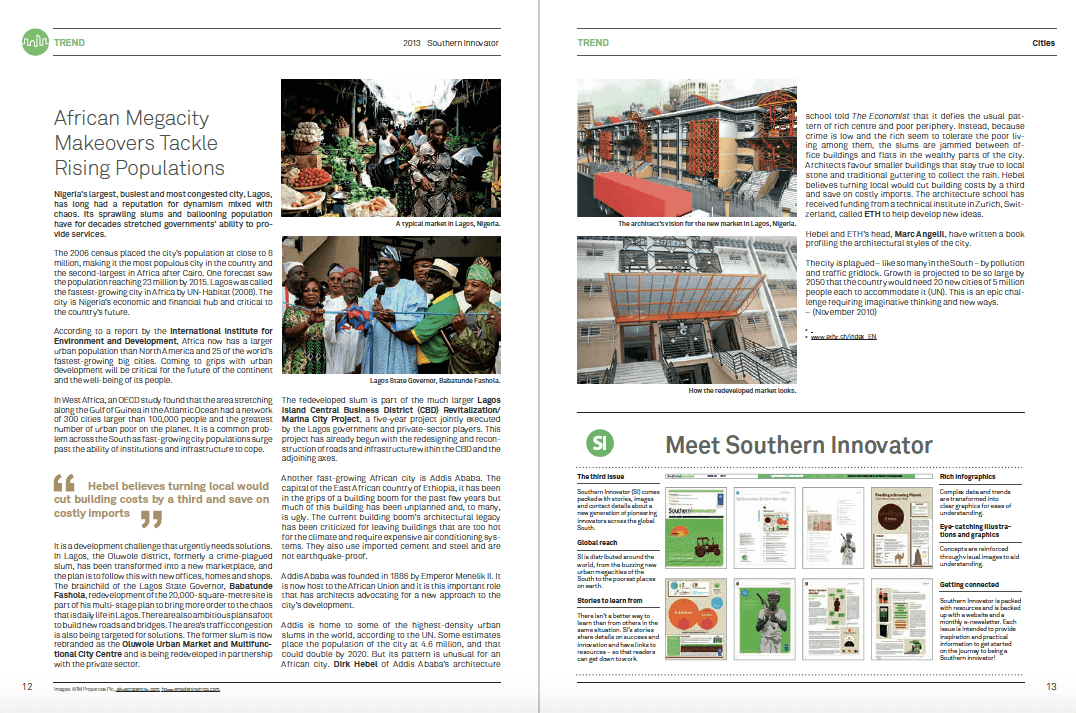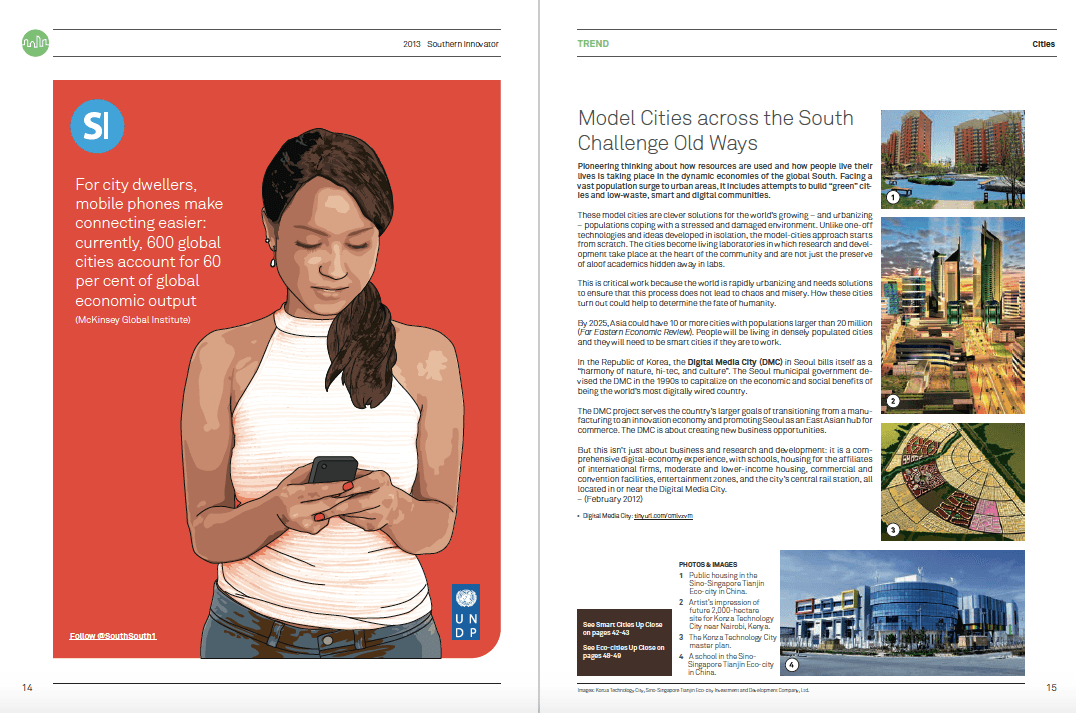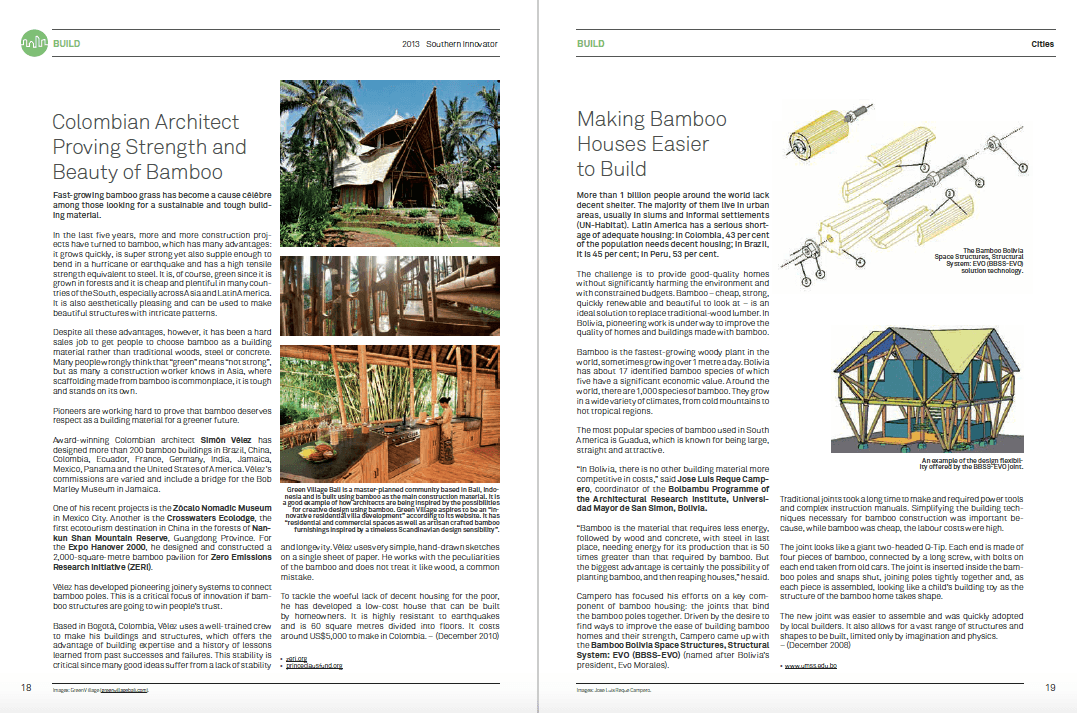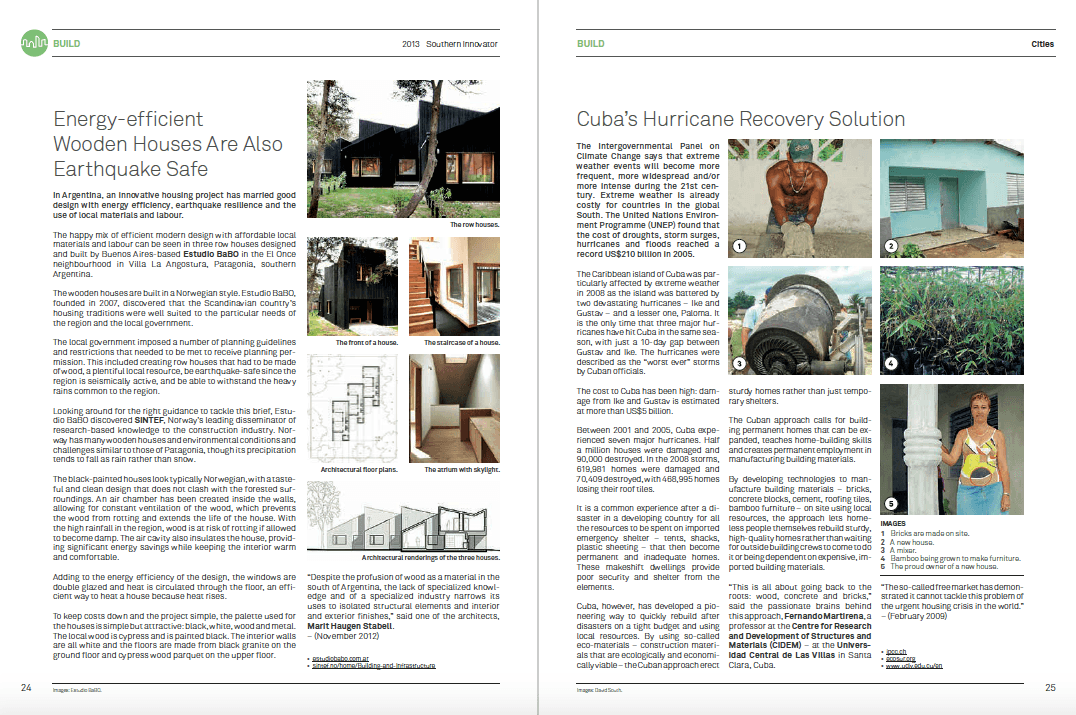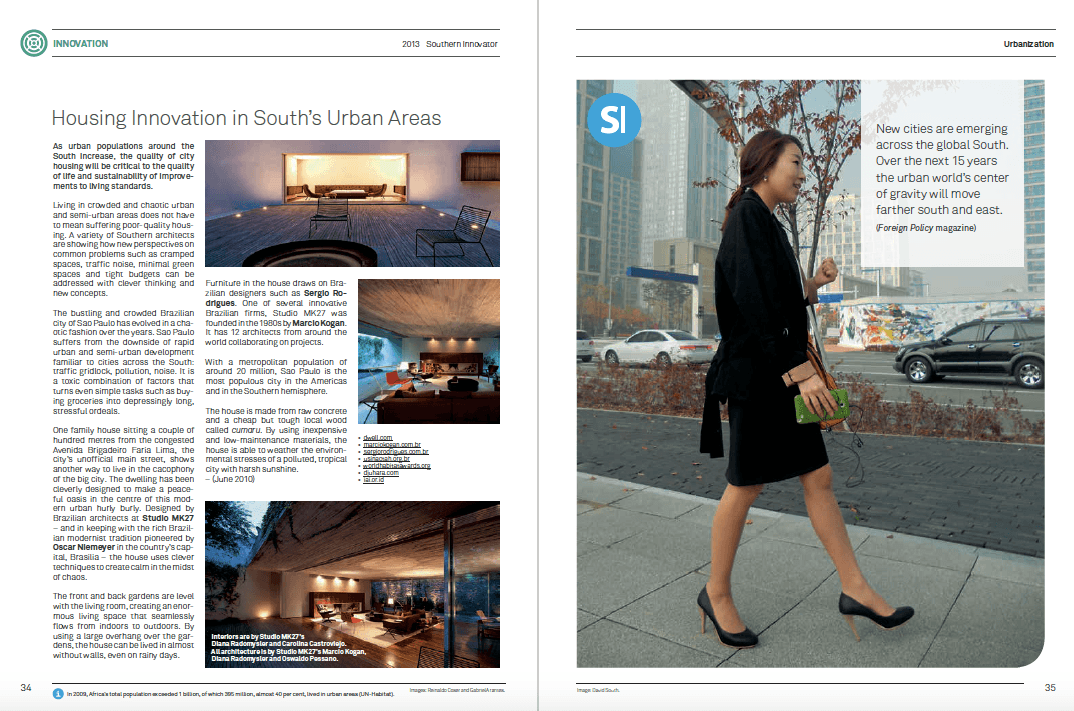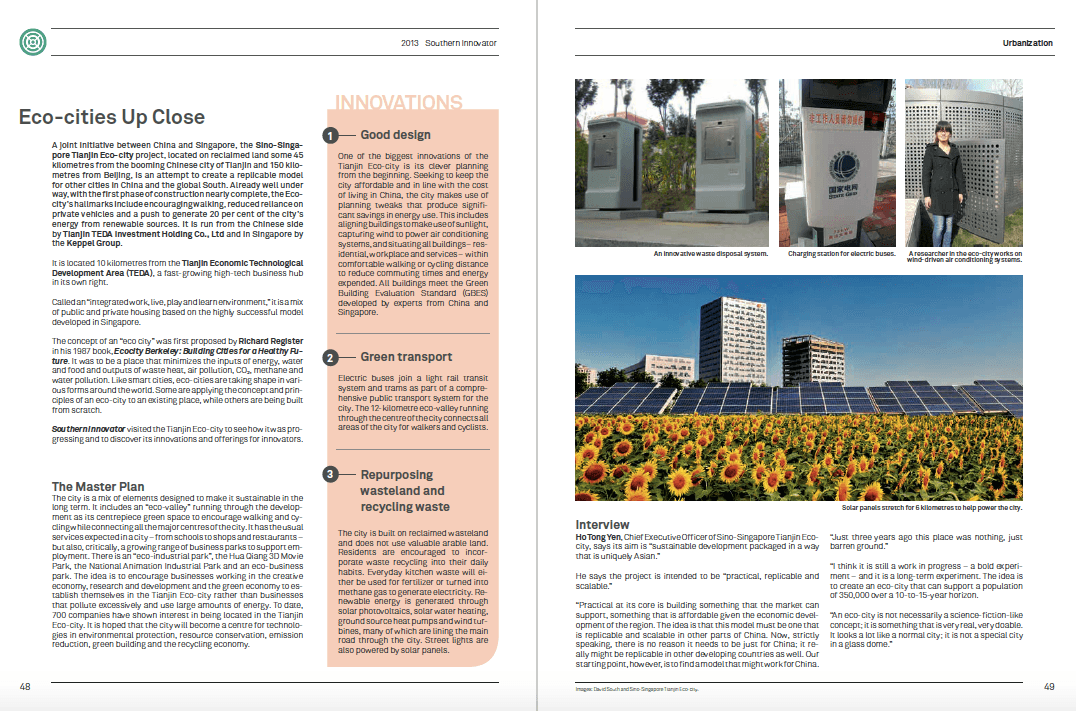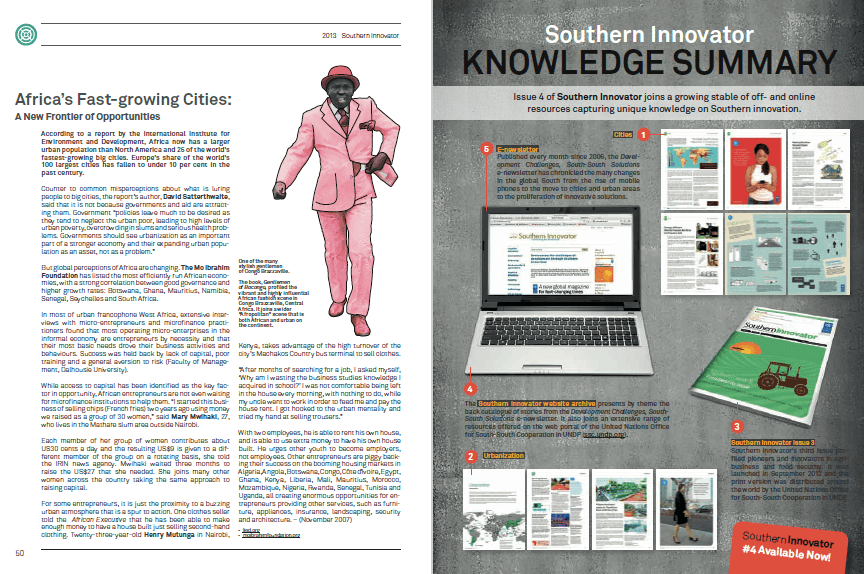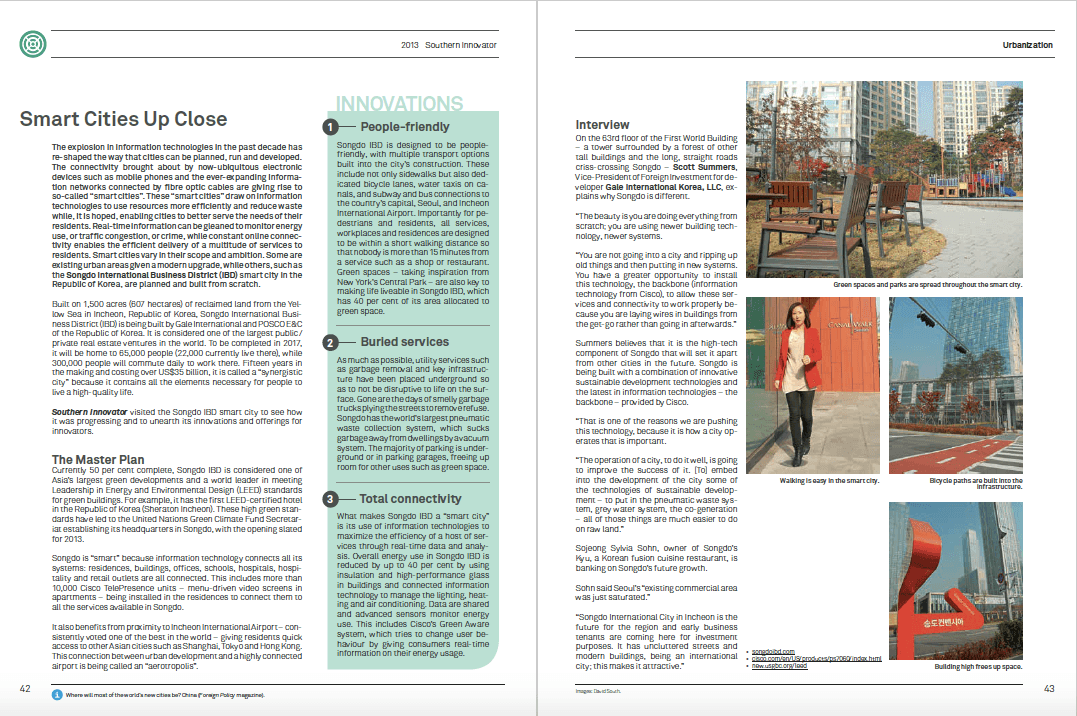Innovator Stories and Profiles | 2012 to 2014
 Saturday, March 5, 2016 at 10:47AM
Saturday, March 5, 2016 at 10:47AM
Southern Innovator was initially launched in 2011 with the goal of - hopefully - inspiring others (just as we had been so inspired by the innovators we contacted and met). The magazine seeks to profile stories, trends, ideas, innovations and innovators overlooked by other media. The magazine grew from the monthly e-newsletter Development Challenges, South-South Solutions published by the United Nations Office for South-South Cooperation (UNOSSC) since 2006.
 Canadian innovator,
Canadian innovator,  Innovator Stories,
Innovator Stories,  Southern Innovator,
Southern Innovator,  UN,
UN,  UNDP,
UNDP,  UNDP Innovator Stories,
UNDP Innovator Stories,  UNOSSC,
UNOSSC,  United Nations,
United Nations,  United Nations Innovator Stories,
United Nations Innovator Stories,  innovator stories and profiles,
innovator stories and profiles,  magazine,
magazine,  stories in
stories in  Agenda 21,
Agenda 21,  Agribusiness,
Agribusiness,  Austerity,
Austerity,  Cities,
Cities,  Cosmas Gitta,
Cosmas Gitta,  Data,
Data,  David South Consulting,
David South Consulting,  Development Challenges, South-South Solutions,
Development Challenges, South-South Solutions,  Digital,
Digital,  Energy,
Energy,  GSSD Expo,
GSSD Expo,  Global South-South Development Expo,
Global South-South Development Expo,  Health,
Health,  Helen Clark,
Helen Clark,  Housing,
Housing,  Hu Rongrong,
Hu Rongrong,  ICT4D,
ICT4D,  Internet,
Internet,  Media,
Media,  Northeast Asia,
Northeast Asia,  Peacekeeping,
Peacekeeping,  Poor,
Poor,  Shock Therapy,
Shock Therapy,  Solutions,
Solutions,  Southern Innovator Magazine,
Southern Innovator Magazine,  Strategy,
Strategy,  Trade,
Trade,  UN Innovator Stories,
UN Innovator Stories,  UNDP,
UNDP,  UNDP Innovator Stories,
UNDP Innovator Stories,  UNOSSC,
UNOSSC,  United Nations,
United Nations,  Wireless,
Wireless,  Women,
Women,  Youth
Youth “Pocket-Friendly” Solution to Help Farmers Go Organic
 Thursday, July 2, 2015 at 3:45AM
Thursday, July 2, 2015 at 3:45AM
Interest in organic food and farming is high, and organics have become a growing global industry. The worldwide market for organic food grew by more than 25 per cent between 2008 and 2011, to US $63 billion, according to pro-organic group the Soil Association. That is an impressive accomplishment given the backdrop of the global economic crisis, and evidence that people value quality food, even in tough times.
One Kenyan company is hoping to help farmers benefit from this global surge in interest in organic food. The company is selling a healthy alternative to chemical fertilizers and is hoping it will soon be able to source its products in Kenya, too.
BioDeposit (http://biodeposit.lv/index.php?page=elixir-3) sells soil conditioner and natural fertilizer made from two ingredients: peat found in marshlands and silt dredged up from lakes, which is called sapropel (http://en.wikipedia.org/wiki/Sapropel). This naturally occurring resource is rich in all the elements required for abundant crops and has the added benefit of not poisoning the soil and water table when used on farmer’s fields.
It is sold as a solution to the multiple pressures hitting farmers, from chaotic weather patterns to soil damage and decreasing yields. It offers a way to boost farm productivity without damaging the soil in the long term.
In 2011 the amount of farmland that was organic reached 37.2 million hectares in 162 countries – but this is still just 0.86 per cent of the world’s agricultural land (Research Institute of Organic Agriculture and International Federation of Organic Agriculture Movements). If BioDeposit has its way, Kenyan farmers could help to grow the number of hectares being farmed organically.
Presenting the solution in October 2013 at the Global South-South Development Expo (southsouthexpo.org) at the headquarters of the UN’s Environment Programme (UNEP) in Nairobi, Kenya, BioDeposit communications and media chief Nelly Makokha (http://ke.linkedin.com/pub/nelly-makokha/29/a08/634), explained that the company is hoping to bring the technology behind BioDeposit to Kenya, if they can get permission.
At present, the source materials for the products are dredged from lakes in Latvia in Eastern Europe. Because of the political structures of Kenya, it means a long political process is ahead to gain permission to dredge any of the country’s lakes. BioDeposit’s Latvian scientists conducted research on the potential for Lake Naivasha (http://en.wikipedia.org/wiki/Lake_Naivasha) in the Rift Valley and claim it has enough deposits to provide Kenya’s farmers with organic fertilizer for the next 200 years.
“If the government agrees, the fertilizer is basically cheaper than any other fertilizer the farmer [will] have ever used in a long time,” said Makokha. “It will be pocket-friendly for them. As they earn more money from the more yields, they are spending less on the fertilizer.
“Our slogan is ‘smart agriculture for health and wealth’ – health in terms of you become organically grown, and if you are looking for organic certification, we will organize that for the certifiers. Right now most countries are looking for organic food and cannot find it.
“So when you become organic that means you earn more money on your products so it means you are healthy and you are wealthy!”
The fertilizer comes in 12 milliliter packets that cost 200 Kenyan shillings (US $2.30). A farmer would need two packets for each quarter acre of farmland.
Based on a Russian discovery from the early 20th century, BioDeposit draws on naturally occurring resources.
Its products include BioDeposit Agro, described as a “biologically active soil conditioner,” and BioDeposit Elixir, described as a “humic plant growth stimulator.” The Elixir is a “sustainable, water-soluble” concentrate made from peat and can be used to soak seeds prior to planting, increasing the germination cycle. For the farmer, it means more seedlings in a shorter time. It also can be poured on compost piles to boost humic content to speed compost decay. Peat is formed from above-ground marsh plants, either on the surface or under a layer of water.
BioDeposit Agro is made from sapropel from the sediment at the bottom of freshwater lakes. It is a renewable, naturally-occurring resource as it has been formed from the accumulated settling of plants such as reeds, algae, trees, grasses and animals over time as they decay.
Unlike other chemical fertilizers, using the BioDeposit product does not require special protective clothing and does not harm human health. Children are also not at risk if they accidentally ingest the product.
“Most farmers have small farms – quarter acre, half acre, at most three acres,” said Makokha. “For a quarter acre you spend five dollars and you get more yields. Two of them would be approximately five dollars – that’s enough for a whole season – so it is pocket friendly.”
And if the company is able to harvest the material in Kenya, it would be even cheaper.
“You can imagine if we dredge here – probably (get the cost down to) a dollar – so it makes more sense for the farmers.”
The dredging has another positive impact: it helps with managing flooding by making the lake deeper once the silt is dredged out, making life better and safer for people living nearby.
BioDeposit has been operating in Kenya for a year and, Makokha said, “the response is awesome.”
BioDeposit organizes workshops for farmers through cooperative societies, helping to guide farmers through the whole process of becoming organically certified.
The company believes its products will help avert problems such as what happened recently when the European Union prevented some flowers – a major source of overseas income for Kenyan farmers – from entering the EU because of banned pesticides.
Cleverly, BioDeposit does most of its business digitally through mobile phones. It conducts its business with sales representatives by phone and conducts training by phone as well. All payments and bank transfers are done by phone using the M-PESA system (http://www.safaricom.co.ke/?id=257).
“It is the easiest way to do business in Kenya,” said Makokha. “Everybody right now owns a mobile phone. When we get the M-PESA, we transfer directly to the account. You get the money and transfer to the bank account and you are done, very easy for everybody … doing wonders for us.”
By David South, Development Challenges, South-South Solutions
Published: March 2014
Development Challenges, South-South Solutions was launched as an e-newsletter in 2006 by UNDP's South-South Cooperation Unit (now the United Nations Office for South-South Cooperation) based in New York, USA. It led on profiling the rise of the global South as an economic powerhouse and was one of the first regular publications to champion the global South's innovators, entrepreneurs, and pioneers. It tracked the key trends that are now so profoundly reshaping how development is seen and done. This includes the rapid take-up of mobile phones and information technology in the global South (as profiled in the first issue of magazine Southern Innovator), the move to becoming a majority urban world, a growing global innovator culture, and the plethora of solutions being developed in the global South to tackle its problems and improve living conditions and boost human development. The success of the e-newsletter led to the launch of the magazine Southern Innovator.
Follow @SouthSouth1
Like this story? Here is a dirty secret: this website is packed with stories about global South innovators. We spent 7 years researching and documenting these stories around the world. We interviewed the innovators to learn from them and we visited them to see how they did it. Why not use the Search bar at the top and tap in a topic and see what stories come up? As for my work, I have been involved with start-ups and media ventures since the early 1990s. While most tech entrepreneurs were either still in their nappies in the 1990s (or just a drunken night away from being conceived in the 2000s), I was developing content for this new thing they called the "Internet". In the years since I have learned a great deal about innovation and digital and have shared these insights in the stories on this website as well as in the 5 issues of Southern Innovator magazine. So, stick around and read some more!
Slideshare: http://www.slideshare.net/DavidSouth1/development-challenges-march-2014-published
Southern Innovator Issue 1: https://books.google.co.uk/books?id=Q1O54YSE2BgC&dq=southern+innovator&source=gbs_navlinks_s
Southern Innovator Issue 2: https://books.google.co.uk/books?id=Ty0N969dcssC&dq=southern+innovator&source=gbs_navlinks_s
Southern Innovator Issue 3: https://books.google.co.uk/books?id=AQNt4YmhZagC&dq=southern+innovator&source=gbs_navlinks_s
Southern Innovator Issue 4: https://books.google.co.uk/books?id=9T_n2tA7l4EC&dq=southern+innovator&source=gbs_navlinks_s
Southern Innovator Issue 5: https://books.google.co.uk/books?id=6ILdAgAAQBAJ&dq=southern+innovator&source=gbs_navlinks_s
 The first five issues of Southern Innovator. The highly influential magazine was distributed around the world and each issue was launched at the annual Global South-South Development (GSSD) Expo hosted by the United Nations Office for South-South Cooperation (UNOSSC).
The first five issues of Southern Innovator. The highly influential magazine was distributed around the world and each issue was launched at the annual Global South-South Development (GSSD) Expo hosted by the United Nations Office for South-South Cooperation (UNOSSC).

This work is licensed under a
Creative Commons Attribution-Noncommercial-No Derivative Works 3.0 License.
 David South,
David South,  Kenya,
Kenya,  South-South Solutions,
South-South Solutions,  UNDP,
UNDP,  UNEP,
UNEP,  farmers,
farmers,  farming,
farming,  global South,
global South,  innovation,
innovation,  innovator,
innovator,  innovators,
innovators,  organic in
organic in  Agribusiness,
Agribusiness,  David South Consulting,
David South Consulting,  Development Challenges, South-South Solutions,
Development Challenges, South-South Solutions,  GSSD Expo,
GSSD Expo,  Global South-South Development Expo,
Global South-South Development Expo,  Poor,
Poor,  Solutions,
Solutions,  Southern Innovator Magazine,
Southern Innovator Magazine,  UN Innovator Stories,
UN Innovator Stories,  UNDP,
UNDP,  UNDP Innovator Stories,
UNDP Innovator Stories,  UNOSSC,
UNOSSC,  United Nations
United Nations Ugandan Fish Sausages Transform Female Fortunes
 Thursday, June 25, 2015 at 9:32AM
Thursday, June 25, 2015 at 9:32AM

What to do when your food production enterprise is just not making much money? It is a common problem in the global South, where farmers and fishers often struggle to survive and can face the threat of bankruptcy and destitution when trying to provide essential food for their communities.
Some fish farmers in Uganda – many of them women – were caught up in this dilemma, unable to find a way to make a good income from the fish they were harvesting.
But a lucky hire for one fish cooperative, in the form of a humble secretary, has turned into a business and food success story that is getting set to jump across borders in Africa.
Lovin Kobusingya is the former secretary and university graduate who, through tenacity and ingenuity, has built a business selling fish sausages that has become a hit in Kampala, Uganda in East Africa.
Through trial and error, Kobusingya came upon the idea of turning the fish into sausages. The product, basically unknown in Uganda before, became a tidy solution to the dilemma of how to sell fish at a premium price that could boost the income of the farmers.
She joins the growing number of female entrepreneurs in Africa. Africa has the highest rate of female entrepreneurship in the world, according to the World Bank, which says two-thirds of women in Africa are in the labour force.
The 29-year-old mother of two set up Kati Fish Farms (http://katifarms.org) and Kati Farm Supplies Ltd. and now sells 500 kilograms of fish sausage a day.
Located in the country’s capital, Kampala, Kati Farm Supplies Ltd. prepares and sells a wide range of food products made with chicken, beef, fish, pork, goat, lamb and honey.
Kobusingya is notable not only for her success as a food entrepreneur, but also for the way she has generated attention and excitement around her business and products.
According to Kenya’s Nation newspaper, Kobusingya boosted her profile by gaining customers in Uganda’s hotels.
She graduated six years ago from Makerere University in Kampala (http://mak.ac.ug) and originally planned to go into banking. Like many graduates, she found it hard to break into the sector and get a steady job. After a year of frustrating job hunting, she found a position as a secretary with a fish cooperative society.
“I got a job after a rigorous interview,” she told the Nation. “It was not well-paying.
“The most challenging part of the job was dealing with fish farmers, who were grappling with an unsteady market for their produce.”
Despite all the problems facing the fish industry, Kobusingya became inspired to do something about it. Rather than just hoping market prices would turn in favour of the fish farmers, she diversified the cooperative’s products to add value to the raw fish ingredients.
“Most of our members were women who had taken up aquaculture (fish farming),” she said. “At the time, this was still a novelty.”
It is a tale of trial and error, as Kobusingya tells it.
“We tried selling our products, such as fish feeds, and even selling directly to consumers. But I felt that there was something more we could do to help the farmers even more.”
Becoming frustrated with the constraints of her role, she decided to start the business on top of her day job. She started buying fish directly from the farmers, filleting it herself and selling it to customers.
Yet, still fish was not selling and going to waste.
Then the eureka moment came: make fish sausages. This had never been done in Uganda and she set about undertaking research on the Internet to learn how to do it.
“I assembled bits and pieces of information from the Net on how to make the sausages,” Kobusyingya said.
“Everywhere I went seeking more information, people thought I was out of my mind.
“Nobody had heard of fish sausages but I received support from the Uganda Industrial Research Institute in 2011. They helped me to develop a formula for the product,” she said.
With the new product developed, Kobusingya tried selling it to the hotels in Kampala. And this was the crucial moment when her fortunes changed: people were excited by the new and novel product.
The first orders earned her US $800 and with that jolt of cash, she was able to launch the product in February 2012.
Production started at 100 kilograms of fish sausage a day. By the third month, she was able to produce 500 kilograms a day. And because the product is so popular, she is running hard to meet demand from hotels, food outlets and institutions.
Expanding into selling smoked fish and frozen chicken and beef, she is now working with 470 fish farmers, most of whom are women.
“This business has motivated farmers throughout Uganda,” she said.
“The enterprise, now worth about Ush50 million (US $19,230), has 16 permanent employees,” she said.
She also took the fish sausages on the road and introduced them to the SmartFish trade event in Lusaka, Zambia, where they became a hit with attendees.
SmartFish (http://www.smartfish-coi.org/#!home/mainPage) is funded by the European Union through the European Development Fund and is implemented by the Indian Ocean Commission in partnership with regional trade organizations. The objective of the event was to increase trade within the region.
With her confidence further boosted by the positive international reaction, Koubusingya is exploring how to sell into Kenya, Tanzania, Rwanda and Burundi.
“I always knew I was a businesswoman,” she told The New York Times. “When I was in high school, I used to sell illegal sweets. And I made money.”
“I am very happy and proud” of being a female entrepreneur. “When I was young, they said: ‘A woman is a woman – a man should take care of you.’ But women are actually contributing a lot more than men. We always find ourselves multitasking,” when juggling work and a family.
By David South, Development Challenges, South-South Solutions
Published: November 2012
Development Challenges, South-South Solutions was launched as an e-newsletter in 2006 by UNDP's South-South Cooperation Unit (now the United Nations Office for South-South Cooperation) based in New York, USA. It led on profiling the rise of the global South as an economic powerhouse and was one of the first regular publications to champion the global South's innovators, entrepreneurs, and pioneers. It tracked the key trends that are now so profoundly reshaping how development is seen and done. This includes the rapid take-up of mobile phones and information technology in the global South (as profiled in the first issue of magazine Southern Innovator), the move to becoming a majority urban world, a growing global innovator culture, and the plethora of solutions being developed in the global South to tackle its problems and improve living conditions and boost human development. The success of the e-newsletter led to the launch of the magazine Southern Innovator.
Follow @SouthSouth1
Google Books: https://books.google.co.uk/books?id=D_A1VeiJWycC&dq=development+challenges+november+2012&source=gbs_navlinks_s
Slideshare: http://www.slideshare.net/DavidSouth1/development-challenges-november-2012-issue
Southern Innovator Issue 1: https://books.google.co.uk/books?id=Q1O54YSE2BgC&dq=southern+innovator&source=gbs_navlinks_s
Southern Innovator Issue 2: https://books.google.co.uk/books?id=Ty0N969dcssC&dq=southern+innovator&source=gbs_navlinks_s
Southern Innovator Issue 3: https://books.google.co.uk/books?id=AQNt4YmhZagC&dq=southern+innovator&source=gbs_navlinks_s
Southern Innovator Issue 4: https://books.google.co.uk/books?id=9T_n2tA7l4EC&dq=southern+innovator&source=gbs_navlinks_s
Southern Innovator Issue 5: https://books.google.co.uk/books?id=6ILdAgAAQBAJ&dq=southern+innovator&source=gbs_navlinks_s

This work is licensed under a
Creative Commons Attribution-Noncommercial-No Derivative Works 3.0 License.
 By David South,
By David South,  Development Challenges,
Development Challenges,  Kampala,
Kampala,  Kati Fish Farms,
Kati Fish Farms,  Makerere University,
Makerere University,  November 2012,
November 2012,  Uganda,
Uganda,  cooperative,
cooperative,  female,
female,  fish sausages,
fish sausages,  women entrepreneurs in
women entrepreneurs in  Agribusiness,
Agribusiness,  David South Consulting,
David South Consulting,  Development Challenges, South-South Solutions,
Development Challenges, South-South Solutions,  GSSD Expo,
GSSD Expo,  Global South-South Development Expo,
Global South-South Development Expo,  Poor,
Poor,  Solutions,
Solutions,  Southern Innovator Magazine,
Southern Innovator Magazine,  UN Innovator Stories,
UN Innovator Stories,  UNDP,
UNDP,  UNDP Innovator Stories,
UNDP Innovator Stories,  UNOSSC,
UNOSSC,  United Nations,
United Nations,  Women
Women Woman Restaurant Entrepreneur Embraces Brand-Driven Growth
 Thursday, June 25, 2015 at 9:30AM
Thursday, June 25, 2015 at 9:30AM

The journey of Zhang Lan is the tale of an entrepreneur who exemplifies the story of globalization. She has gone from working many part-time jobs while studying overseas, to becoming one of China’s most successful food entrepreneurs.
Starting with a very small and humble restaurant specializing in spicy food from China’s Sichuan province, Zhang has cannily used branding innovation to grow her business and build her reputation in the food trade. Today the company she started, South Beauty Group (southbeauty.com), has 71 restaurants, most in major cities such as Beijing and Shanghai.
A series of bold moves focused on raising the profile of her restaurants and the South Beauty Group has paid off: the group was singled out by the China Hotel Association as one of the top 10 Chinese restaurant brands. By riding the country’s breakneck growth and urbanization, her restaurant group has enjoyed double-digit growth in recent years in revenue and profits.
Zhang’s mission is to revitalize the Chinese restaurant scene by introducing a more upscale and consistent dining experience.
China’s restaurant industry is booming and represents a significant opportunity: it is said it will have revenue of 3.7 trillion yuan (US $590 billion) by 2015 (China Daily).
“Most people in China don’t know how to present food. I am happy that I have given some importance to the appearance of food,” Zhang told the China Daily newspaper.
“I strike a balance between popular and high-end brands in my daily life. This also works for South Beauty Group, which aims to attract customers to a modern place to enjoy high-grade and popular Chinese cuisine.”
Her business mission is to take the group outside of China and become a global brand.
“Buoyed by the booming domestic high-end catering market, South Beauty Group is looking to be a major luxury brand in the global catering industry. It is not an easy task considering that there are different cultures and eating habits. But my past experience has taught me that opportunities often come along with challenges,” she told China Daily.
Zhang’s business story started in a journey to Canada to pursue further education. To make ends meet, at one time she took on six part-time jobs, including washing dishes and food preparation.
Anybody who has gone to another country to work and better their life knows how hard this can be: “During that period, I was so tired by the end of the day that I had to lift my legs onto the bed with my hands,” Zhang said.
But working hard in restaurants and beauty shops earned her US $20,000 in savings within two years.
She returned to Beijing in the early 1990s, a time when the country was undergoing significant market reforms. She opened a small restaurant in Beijing in 1991 serving Sichuan cuisine. Dining out was still a new experience in a country that had spent decades under austere communism. She made her restaurant different by emphasizing cleanliness and unique flavours for the food. She even used the design of the restaurant to set it apart: she gathered bamboo from Sichuan and used it to transform the restaurant into a little bamboo house.
This attention to detail paid off. By 2000, Zhang had been successful enough to give her the confidence to open her first South Beauty Restaurant in Beijing’s China World Trade Center, a high-end office building in the Central Business District. It proved to be a great way to boost her business’s profile.
“It was a bold decision, as rents were high, but I knew the returns would also be high,” she said.
By 2006, she was successful enough to make another brave move: open a luxury restaurant called the Lan Club, in Beijing. Having learned about the importance of distinguishing herself in the ever-growing restaurant marketplace in China, she invited world-famous designer Philippe Starck (http://www.starck.com/en/) to design the restaurant.
For Zhang, there was a bigger strategy at work: “I was not disheartened when some people said that I threw money away like dirt and 12 million yuan (US $1.92 million) was too much for a design draft. But I got great publicity and brand recognition with this design, far more than what is received by most companies which spend millions of yuan on television advertisements. Not everyone in China can boast of a Starck design in their restaurant.”
In 2007, the company also started cooking meals for airlines flying between China and France, the Netherlands and South Korea. In 2008, it won the bid to be food and beverage provider for the 2008 Beijing Olympics and was named official caterer to the 2010 Shanghai World Expo.
“These international events have given us great confidence in planning overseas expansion,” Zhang said.
The hallmarks of the dining experience at a South Beauty Restaurant include dramatic food presentation, upscale décor, a pleasant dining atmosphere and critically, waiting staff who are informed about the dishes they are serving.
Dramatic food preparation includes cooking food at the table for the diners and serving stir-fried shrimp on a plate with a goldfish bowl filled with live fish.
“I want to change the cheap price and bad atmosphere tag that most Westerners have about Chinese food,” Zhang told China Daily.
She has attracted investors to take a stake in the business and become the second richest female entrepreneur in China, according to the 2011 China Restaurant Rich List.
While the international economic crisis is still damaging growth in the United States and Europe, Zhang still plans to go global. She is looking to initially expand into Asia before moving into Europe and North America.
“Our mission is to promote authentic Chinese cuisine across the world. With (the) Chinese economy growing steadily and its cultural influence gaining, it will not be long before we see some big global Chinese catering companies, much like McDonald’s,” Zhang concluded. And it looks like South Beauty Group wants to lead the way.
By David South, Development Challenges, South-South Solutions
Published: November 2012
Development Challenges, South-South Solutions was launched as an e-newsletter in 2006 by UNDP's South-South Cooperation Unit (now the United Nations Office for South-South Cooperation) based in New York, USA. It led on profiling the rise of the global South as an economic powerhouse and was one of the first regular publications to champion the global South's innovators, entrepreneurs, and pioneers. It tracked the key trends that are now so profoundly reshaping how development is seen and done. This includes the rapid take-up of mobile phones and information technology in the global South (as profiled in the first issue of magazine Southern Innovator), the move to becoming a majority urban world, a growing global innovator culture, and the plethora of solutions being developed in the global South to tackle its problems and improve living conditions and boost human development. The success of the e-newsletter led to the launch of the magazine Southern Innovator.
Follow @SouthSouth1
Google Books: https://books.google.co.uk/books?id=D_A1VeiJWycC&dq=development+challenges+november+2012&source=gbs_navlinks_s
Slideshare: http://www.slideshare.net/DavidSouth1/development-challenges-november-2012-issue
Southern Innovator Issue 1: https://books.google.co.uk/books?id=Q1O54YSE2BgC&dq=southern+innovator&source=gbs_navlinks_s
Southern Innovator Issue 2: https://books.google.co.uk/books?id=Ty0N969dcssC&dq=southern+innovator&source=gbs_navlinks_s
Southern Innovator Issue 3: https://books.google.co.uk/books?id=AQNt4YmhZagC&dq=southern+innovator&source=gbs_navlinks_s
Southern Innovator Issue 4: https://books.google.co.uk/books?id=9T_n2tA7l4EC&dq=southern+innovator&source=gbs_navlinks_s
Southern Innovator Issue 5: https://books.google.co.uk/books?id=6ILdAgAAQBAJ&dq=southern+innovator&source=gbs_navlinks_s

This work is licensed under a
Creative Commons Attribution-Noncommercial-No Derivative Works 3.0 License.
 By David South,
By David South,  China Daily,
China Daily,  China Hotel Group,
China Hotel Group,  November 2012,
November 2012,  Sichuan province,
Sichuan province,  South Beauty Group,
South Beauty Group,  UNOSSC,
UNOSSC,  Zhang Lan,
Zhang Lan,  brand,
brand,  food entrepreneurs,
food entrepreneurs,  globalization,
globalization,  restaurant in
restaurant in  Agribusiness,
Agribusiness,  David South Consulting,
David South Consulting,  Development Challenges, South-South Solutions,
Development Challenges, South-South Solutions,  GSSD Expo,
GSSD Expo,  Global South-South Development Expo,
Global South-South Development Expo,  Northeast Asia,
Northeast Asia,  Poor,
Poor,  Solutions,
Solutions,  Southern Innovator Magazine,
Southern Innovator Magazine,  UN Innovator Stories,
UN Innovator Stories,  UNDP,
UNDP,  UNDP Innovator Stories,
UNDP Innovator Stories,  UNOSSC,
UNOSSC,  United Nations,
United Nations,  Women
Women An Innovator’s ‘Big Chicken Agenda’ for Africa
 Thursday, June 25, 2015 at 8:44AM
Thursday, June 25, 2015 at 8:44AM

Increasing the quantity and quality of food in Africa will be critical to improving the continent’s human development. And a key element in giving Africa a more secure food supply will be boosting science and knowledge on the continent and making sure it is focused on Africa’s needs and situation.
One pioneering scientist is looking to the humble chicken to tackle two big problems in Africa: food security and household incomes. By pumping up the weight and productivity of African chickens, she hopes to eradicate hunger and boost household incomes.
Kenyan scientist Sheila Ommeh (http://www.awardfellowships.org/participants/success-stories/108-sheilaommeh.html ) is showing how local knowledge can give farmers the edge when it comes to improving Africa’s animal stock. An animal geneticist, she is trying to create a disease-resistant African chicken that can also produce plenty of eggs.
Her pioneering work is about trailblazing “a big chicken agenda in Africa,” she explained to TrustLaw, a global hub for free legal assistance and information on good governance and women’s rights. She grew up in an area – Mount Elgon in western Kenya – where raising chickens was the primary source of both income and food. Her family raised chickens and the income from this helped to pay for her schooling.
Raising chickens is common in rural Kenya, and many of the people doing it are women.
Based on her experience, she saw how virulent diseases kill chicken flocks and destroy family incomes and disrupt lives – diseases like Newcastle (http://www.avianbiotech.com/diseases/newcastle.htm) and Gumboro (gumboro.com).
She works at the International Livestock Research Institute (ilri.org) based in Nairobi, Kenya. The ILRI “works at the crossroads of livestock and poverty, bringing high-quality science and capacity-building to bear on poverty reduction and sustainable development” and conducts research in Africa, South and Southeast Asia and China.
“I’m really passionate about giving back to the community an improved chicken that will really help their lives,” she explains.
Another project she is working on is the development of a drought-tolerant chicken. This chicken could prove very helpful in parts of Africa suffering from drought and hunger, like in the Horn of Africa.
Women are considered to be the majority producers of food in Africa yet just one in four people working in agricultural research in Africa is a woman, according to TrustLaw.
Ommeh has a PhD in chicken genetics and is a staunch believer in seeking out solutions to Africa’s problems within Africa: “In my view = it’s about time Africa looked for solutions in Africa for Africa,” she told a group of British Members of Parliament.
She will continue her research by looking at native African chickens. She is worried indigenous African chickens are being wiped out by cross-breeding and the introduction into the continent of exotic breeds, which are making African chickens more susceptible to viruses.
Her goal is to produce a disease-resistant breed of chicken weighing four kilograms and laying 250 eggs a year. This would be a big increase on current average weights, and a trebling of the yield.
“Definitely the incomes of these households will increase and that will (create) a rippling effect that will trickle up … And we hope that in 10 to 15 years the poverty issue in Africa will not be so serious,” Ommeh said.
“Chicken is a small livestock but I believe it has the capacity to have a big impact.”
For female scientists working in agriculture, African Women in Agricultural Research and Development (AWARD) (http://awardfellowships.org/) is seeking researchers looking to boost their technical and leadership skills. It is hoped that supporting more women researchers will have the effect of turning research priorities towards the needs of smallholder farmers, who make up the majority of farmers in Africa.
By David South, Development Challenges, South-South Solutions
Published: May 2012
Development Challenges, South-South Solutions was launched as an e-newsletter in 2006 by UNDP's South-South Cooperation Unit (now the United Nations Office for South-South Cooperation) based in New York, USA. It led on profiling the rise of the global South as an economic powerhouse and was one of the first regular publications to champion the global South's innovators, entrepreneurs, and pioneers. It tracked the key trends that are now so profoundly reshaping how development is seen and done. This includes the rapid take-up of mobile phones and information technology in the global South (as profiled in the first issue of magazine Southern Innovator), the move to becoming a majority urban world, a growing global innovator culture, and the plethora of solutions being developed in the global South to tackle its problems and improve living conditions and boost human development. The success of the e-newsletter led to the launch of the magazine Southern Innovator.
Follow @SouthSouth1
Google Books: https://books.google.co.uk/books?id=m5GYBgAAQBAJ&dq=development+challenges+may+2012&source=gbs_navlinks_s
Slideshare: http://www.slideshare.net/DavidSouth1/development-challengessouthsouthsolutionsmay2012issue
Southern Innovator Issue 1: https://books.google.co.uk/books?id=Q1O54YSE2BgC&dq=southern+innovator&source=gbs_navlinks_s
Southern Innovator Issue 2: https://books.google.co.uk/books?id=Ty0N969dcssC&dq=southern+innovator&source=gbs_navlinks_s
Southern Innovator Issue 3: https://books.google.co.uk/books?id=AQNt4YmhZagC&dq=southern+innovator&source=gbs_navlinks_s
Southern Innovator Issue 4: https://books.google.co.uk/books?id=9T_n2tA7l4EC&dq=southern+innovator&source=gbs_navlinks_s
Southern Innovator Issue 5: https://books.google.co.uk/books?id=6ILdAgAAQBAJ&dq=southern+innovator&source=gbs_navlinks_s

This work is licensed under a
Creative Commons Attribution-Noncommercial-No Derivative Works 3.0 License.
 Africa,
Africa,  Chicken,
Chicken,  International Livestock Research Institute,
International Livestock Research Institute,  Kenya,
Kenya,  Nairobi,
Nairobi,  Sheila Ommeh,
Sheila Ommeh,  agenda,
agenda,  eggs,
eggs,  innovator in
innovator in  Agribusiness,
Agribusiness,  David South Consulting,
David South Consulting,  Development Challenges, South-South Solutions,
Development Challenges, South-South Solutions,  GSSD Expo,
GSSD Expo,  Genetics,
Genetics,  Global South-South Development Expo,
Global South-South Development Expo,  Solutions,
Solutions,  Southern Innovator Magazine,
Southern Innovator Magazine,  Strategy,
Strategy,  UN Innovator Stories,
UN Innovator Stories,  UNDP,
UNDP,  UNDP Innovator Stories,
UNDP Innovator Stories,  UNOSSC,
UNOSSC,  United Nations
United Nations 